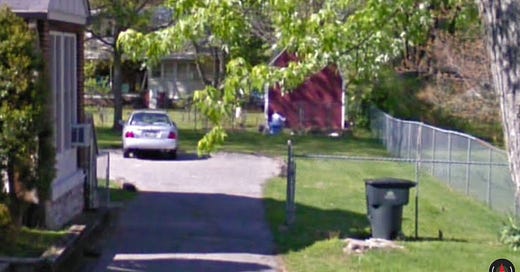Gravel
Regarding my last piece on new potatoes from my garden, this is my third summer gardening. We had just moved into our current house in March of 2020 when the pandemic sent me out into the backyard with a shovel and an ambitious plan. Enthusiasm carried me through several weeks of digging, and by the time I was done, I had carved out six decent-sized garden beds in a moderately sunny part of the yard.
I say “moderately sunny”, because my backyard is dominated by three enormous trees squatting right in the middle, one of them a black walnut. Worse, the sunniest part of the yard, about a fifth of the whole, is covered in six inches of gravel, left over from when previous occupants (college students) had parked in the back yard. You can see it on the Google Street View from 2009.
That gravel is still there, 13 years later, now covered by a thin layer of grass.

I’ve nibbled at the edges of that gravel deposit, to the extent of digging out a narrow strip along one side, now planted with onions. But it was a laborious effort for a stout, middle-aged man with a shovel, and the soil underneath the gravel wasn’t worth the effort to reveal. I had to bring in a few bags of garden soil to make the space useable. Someday, when I’m made of money, I’ll hire a backhoe to come in and scrape it clean, then follow up with a load of fresh soil. Until then, I’ll have to be satisfied with what i have.
Cucumbers
In that photo above, taken this morning, you can see that I’ve planted cucumbers on the fence to the right of the gate. This year, I planted two varieties: Marketmore 76, a table cucumber famous for its vigor and productivity, and Boston Pickling, an old-fashioned pickling cuke. Despite its reputation, the Marketmore has been underwhelming. It started slowly from seeds, and seemed sickly and stunted when I transplanted it, and is now, in mid-June, barely reaching halfway up the fence. Unfortunately, the Boston Pickling is not a good fresh-eating cucumber. It’s too dry and tends to bitterness. (The jury is out on its pickling qualities.) So, I’m not enjoying fresh cucumbers like I should be in June.
In the previous two years, I’ve planted a variety called Arkansas Little Leaf, which produced abundant yields and was both a good eating cucumber and a good pickler. I should have stuck with that.
By the way, my asparagus patch is directly behind the cucumber fence.
Southern Insects
As a Californian, I’ve long been astounded at the fauna of the South, specifically the insects. I’ve spent something like 17 of my 40 adult years living in the South, between Virginia, Georgia, Alabama and Tennessee, where I’ve been for more than a decade, and in all that time, I’m still surprised by the bugs.
We don’t have fireflies in California. Catching them in jars was not part of my childhood. We caught other, less exiting bugs in jars. I have a stitches-shaped scar between the thumb and forefinger of my left hand where a steak knife that should have been punching holes in a jar lid accidentally punched a hole in my hand when I was 9. So, I know all about putting insects in jars, and would have loved a chance to put a firefly in one when I was 10.
The consequence of not having a childhood with fireflies is that I’m still excited by the first flash of light in late spring. God has filled this part of the world with whimsical, bumbling insects that can barely fly and light up at dusk? How hilarious and delightful!
Unfortunately, Southern entomological abundance is not just fireflies. Two years ago, as spring turned to summer in my backyard, I rediscovered the chigger, an insect I first encountered in my grandparents’ East Texas pecan orchard in 1974.
I had forgotten how horrible chiggers are.
I was recently trying to explain the chigger to my sister-in-law who lives in Boston and hasn’t spent much time in the South. People don’t believe you when you tell them that chiggers, tiny bugs you can’t see, will mess you up. I was tempted to send her out into the backyard to stand around in the deep grass between my garden beds, so as to experience them first-hand.
It’s all fun and games in the garden until you fall into a patch of hungry chiggers.

Appiza in South Carolina?
Regarding something I had written a few weeks ago, about how you can’t get real New Haven pizza (apizza!) outside of coastal Connecticut, I recently received this email from Cliff Garzzillo of Aiken, South Carolina.
Good morning one of my customers brought me your article about New Haven Apizza.
You end your article with a question, why is it so difficult to duplicate New Haven style pizza outside of coastal Connecticut? If you’re ever down in Aiken, South Carolina, please come in to Apizza Di Napoli and try our New Haven pizza. I guarantee you you will not be disappointed and you will be reminded of what you had while in New Haven. Having grown-up in Fair Haven and visited the pizzerias that you mentioned, we have captured the essence of New Haven pizza.Even Road Food famous food critic Michael Stern agrees, our New Haven is probably one of the best outside of the city of New Haven. Please don’t hesitate to give us a try if you’re ever in the area.
Thanks,
Cliff Garzzillo
Owner
Apizza di Napoli
Aiken, SC 29803
I don’t know if Mr. Garzzillo’s pizza will rival Sally’s or Frank Pepe’s, but I do know that the next time I’m in South Carolina, I’ll be detouring to Aiken to give Apizza di Napoli a try. I especially appreciate Mr. Garzzillo’s enthusiasm for his own food. A restaurant owner who tracks down random internet writers to brag about his pizza is someone who loves what he does, and that’s a big plus in my book. His pizza has to be good if he cares about it that much.
If any of you readers have been to Apizza di Napoli in Aiken, SC, let me know what you think in the comments below.
Thanks for reading! I’ll be back on Thursday with something new. Cheers!





Hi there, you are not wrong about chiggers. When I was a kid, I learned the hard way never to touch Spanish moss (everywhere in the live oaks throughout my hometown, coastal NC), and around here they seem especially to like living in ditches. Your clue there is "deep grass". I don't know how TN is for ticks, but we keep things short against not only chiggers but ticks. One more tip - bird feeders. We feed hummingbirds in the summers and everything else in the winters. They come for the goodies but stick around for ticks, skeeters, gnats, grubs, and whatever else. When we first took this place over (after a relative had aged in place and let things go), we could hardly go outside in warm weather without slathering on bug juice, or else come back with welts and worse from the bites and stings. I don't even bother nowadays. Attract some birds and cut that grass so you can better enjoy that nice backyard!